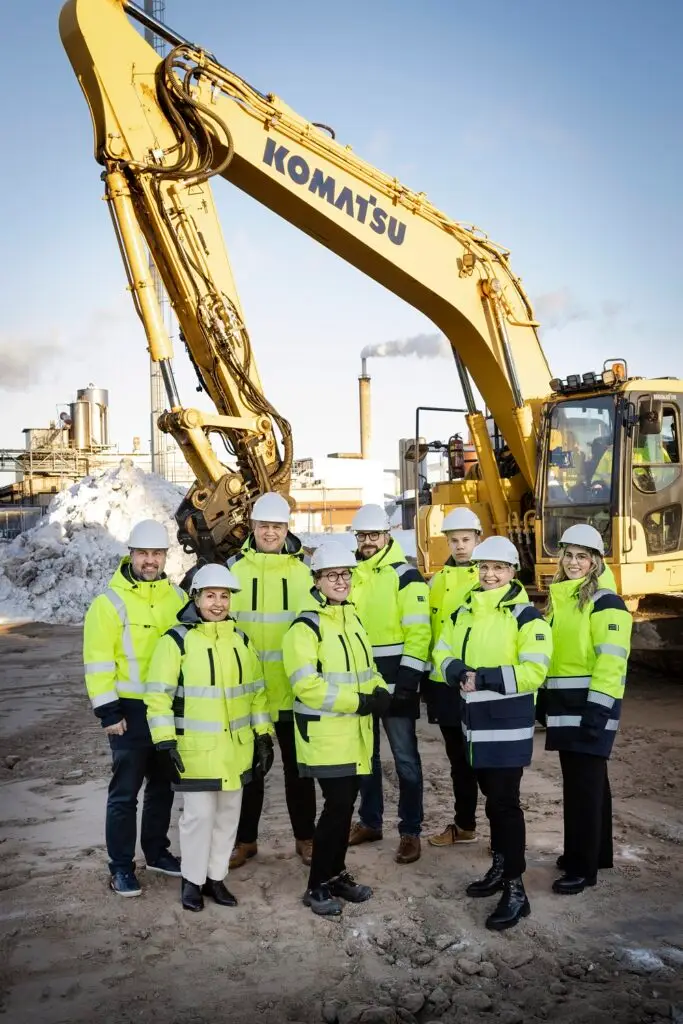This article was originally published on LinkedIn by Ville Klaavu
On a snowy day in January this year, an excavator dug up the first bucket of soil near the port of Kokkola, Finland. Thus began the construction phase of Europe’s largest methane-splitting hydrogen plant. I saw many smiling faces around me because we knew that with this event, we were taking a significant step to decarbonizing industries across the world.

We call this plant our Customer Sample Facility (CSF), and its nominal capacity will reach 2,000 tons of hydrogen and 6,000 tons of high-quality carbon per year once the project is complete. When it starts operations in the fall, CSF will be the largest methane-splitting plant in Europe, but it’s just a beginning in our journey.
The plant will produce both low-carbon hydrogen and high-quality solid carbon products to demonstrate the viability of Hycamite’s new methane-splitting technology. This technology decomposes large volumes of methane into its component elements – hydrogen and carbon – without releasing greenhouse gases into the atmosphere. The process is also called methane pyrolysis.
The decarbonization capacity of CSF can reach 18,000 tons of CO2 per year when liquefied natural gas (LNG) is used. Based on a life-cycle assessment (LCA) of Hycamite’s methane-splitting technology by the non-profit German research institute FfE, our carbon footprint in Finland is below 1kg CO2e/kg H2. When biogas is used as the methane source, we create a carbon sink.
Numbers aside, I find it most fascinating that CSF will serve as a developmental hub for decarbonization process across the world.
We collaborate from conceptualization to implementation
Our task at Hycamite is to conceptualize decarbonization pathways with our partners for industrial end-users of hydrogen and carbon products. We make carbon removal agreements with the end-users. That’s why Hycamite plants will be built next to several kinds of industries like chemical factories as well as iron and steel factories. Clean hydrogen is a versatile fuel that can also be used in power generation and transportation.
Together with our partners, we collaborate with end clients on project planning, designing and permitting. We study the ideal location near the industrial client’s facility and, for example, the availability of excess heat. Our experts produce valuable data to correctly plan the client’s investment. We optimize the decarbonization capacity. We work together to collect, prepare and submit all required information and documents for the system study and permissions.
Many clients aim for gradual decarbonization. To achieve this, methane splitting starts with a limited proportion of hydrogen. When the client, equipment and infrastructure are ready, the share of hydrogen in the gas mixture can be increased.
Modularity gives advantages
We produce decarbonization technology for plants as modules in series production for fast growth, easy scalability and competitive production costs. Standardized solutions minimize engineering, construction and maintenance costs. Plus, modularity means the installation time can usually be reduced to as little as six months.
Reactor units can be combined to reach desired capacity. Gas feed, carbon separation and other downstream process modules will fit these standard reactor sizes. Initially, there will be three standardized reactor sizes to achieve a wide production span ranging from a few kilotons to hundreds of kilotons annually.
The modular approach will cover everything from engineering to commissioning. The core technology will arrive at the site as modules.
Hycamite’s control system with full digital twin, developed together with ABB, will run and optimize the whole process and integrate it into the client’s factory automation system.
For Hycamite plants in the USA, modules will be made in America. During construction, local, preselected EPC partners will support clients with local regulatory compliance, project requirements and installation.
We will provide 24/7 control and support
In the next few years, Hycamite will operate several plants in North America. Some of them may be far larger than CSF. Nevertheless, the site in Finland will continue to play a key role in developing worldwide operations.
Ultimately, the Remote Operations Center next to CSF will provide around-the-clock control of and support for the global network of Hycamite plants. Hycamite will never leave our clients alone to face the challenges that may arise in their daily operations.
Hycamite process is developed in Finland
CSF will be the development site for the Hycamite process. To meet individual client needs, CSF will also be a testing center. For instance, some industrial clients are looking for certain reactor types. Others have specific needs for catalysts. CSF will test required solutions first.
In addition, CSF will also test various methane sources. Hycamite’s feedstock is methane – widely available, able to rapidly scale and easy to store and transport using existing infrastructure. Methane can come from geologic natural gas, biomethane, or synthetic natural gas. Even the sidestreams of petrochemical industry can be used. To ensure an understanding of issues and ideas related to different methane source, CSF will use both LNG from Norway and biomethane from Finland.
We transform the tradition
You may not be familiar with Kokkola, the headquarters of Hycamite. The coastal city in western Finland has about 50,000 inhabitants. Despite its small size, Kokkola is home to northern Europe’s largest ecosystem of the inorganic chemical industry. It’s also a major center for producing battery chemicals and materials by large international companies.
There is a reason why we develop everything here. There is a long tradition of producing and using so-called grey, steam methane reforming (SMR) hydrogen in Kokkola, and Hycamite will evolve this tradition for the low-carbon era with its so-called turquoise hydrogen. Without SMR hydrogen production emissions and with only 13% of the energy required for hydrogen production by electrolysis, Hycamite’s methane-splitting technology can transform several industries at competitive costs.







